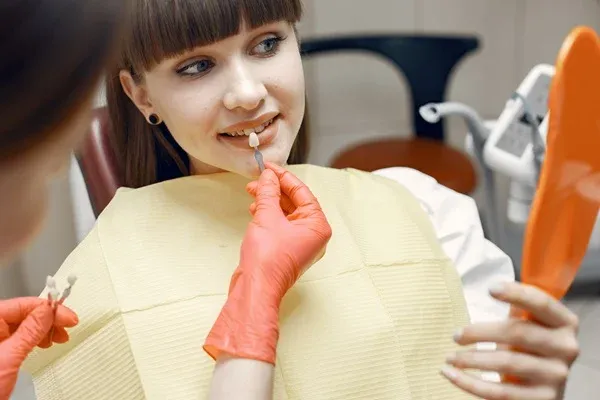Combining Invisalign with Other Dental Treatments
Invisalign can be combined with other dental treatments to ensure that the patient receives a full and complete solution to their dental problems and to achieve the best aesthetic results. Invisalign clear aligners that are nearly invisible and comfortable can be combined with other treatments like whitening, veneers, implants, crowns, and periodontal therapy. These treatments are planned and performed so that patients can treat several dental issues at once, not only improving the appearance of the teeth but also their functionality. This blog focuses on the possibilities of using Invisalign together with other dental treatments to achieve the best outcomes.
Invisalign and Teeth Whitening
Invisalign treatment, together with teeth whitening, can help patients attain a beautiful set of straight and white teeth. Here’s how these treatments can work together effectively:
- Before Invisalign: The whitening of the teeth can be done at the beginning of the Invisalign treatment to achieve the final shade of veneers or crowns that might be placed in the future.
- During Invisalign: Whitening treatments can be done while the Invisalign treatment is going on. It is possible to use the aligners as whitening trays, thus maintaining the position of the whitening gel.
- After Invisalign: After this, other treatments such as whitening can be done to improve the look of the newly aligned teeth.
Invisalign and teeth whitening can be coordinated in a way that is very smooth and will leave you with a beautiful, aligned, and bright smile. When administered together, these treatments can be completed under the supervision of a dentist and meet the patient’s aesthetic and functional goals.
Invisalign and Veneers
Invisalign and veneers are two dental procedures that can be used together to achieve significant enhancement of the position and appearance of your teeth. Here’s how these treatments complement each other:
How Invisalign Can Improve Outcome of Veneers
- Optimal Alignment: Veneers are placed on well-aligned teeth, and Invisalign can straighten the teeth before placing the veneers. This is useful to avoid a more artificial appearance and a better adjustment of the prosthesis.
- Preparation for Veneers: In the case of Invisalign aligning the teeth first, less of the enamel will have to be shaved off to accommodate the veneers.
- Improved Bite: Misaligned teeth can be realigned, and this will help to correct the bite force; therefore, the veneers will not wear out easily.
Planning Treatment Sequence
- Initial Consultation: It is therefore advisable to seek professional advice from a dental professional to get the correct diagnosis and the best treatment plan. This involves evaluating the position of the teeth and whether the patient requires veneers or not.
- Invisalign Treatment: As a rule, Invisalign treatment is carried out initially to obtain the required alignment. It depends on the case, but it can take from a few months to one and a half years.
- Veneer Placement: Veneers can be made to fit and placed after Invisalign treatment has been done. This entails making impressions, constructing the veneers, and cementing them on the teeth.
Invisalign with veneers is a good combination because it covers both functional correction and cosmetic improvement. According to the treatment plan and cooperation with a dental specialist, patients can have a beautiful and healthy smile with aesthetic and functional characteristics.

Invisalign and Dental Implants
Invisalign treatment, when used together with dental implants, should be well planned and coordinated to achieve the best results in both alignment of teeth and replacement. Here’s how these treatments can work together effectively:
- Pre-Implant Alignment: Often, Invisalign treatment is carried out initially to achieve the proper alignment of the teeth and create the required space for the dental implant. This makes it possible to have the best placement and functionality of the implant.
- Post-Implant Adjustment: Even if the implant is already there, Invisalign can be applied to fine-tune the position of the neighboring teeth. The fixed implant can be incorporated into the aligner so that the aligner is made to fit the patient’s mouth.
Invisalign when used together with dental implants can offer the patient a properly aligned, functional, and beautiful smile. With proper coordination and cooperation between dental specialists, patients can attain the best outcomes where both misalignment and missing teeth issues are solved efficiently.
Invisalign and Crowns/Bridges
Invisalign, when used in combination with crowns and bridges, can be used to align and restore teeth and give the patient a healthier and more beautiful smile. Here’s how these treatments can be integrated effectively:
- Assessment: It is important to conduct a full dental examination to establish whether the current crowns and bridges can be used with Invisalign. This involves assessing the status and location of the restorations.
- Customization: Invisalign aligners can be made to accommodate existing crowns and bridges, which means the aligners will fit well and effectively move the teeth.
- Sequential Planning: If crowns or bridges are needed, the sequence of the treatments must be considered and discussed. This may require undergoing Invisalign first to get the proper alignment before getting new crowns or bridges.
- Temporary Crowns: Sometimes, transitional crowns may be used during the Invisalign treatment. Once the alignment is done, permanent crowns can then be fitted to correspond to the new positions of the teeth.
- Bridge Considerations: Especially for bridges since they are constructions that are placed on more than one tooth. Bridges can be incorporated into aligner therapy. However, the movement of the abutment teeth is limited.
Invisalign treatment, together with crowns and bridges, is complex and should be done in consultation with orthodontists and general dentist.
Using Retainers with Invisalign
- Retention Phase: When the Invisalign treatment is done, retainers are worn to keep the teeth aligned as they were rearranged. These can be the conventional wire retainers or the clear ones which are made for the patient’s teeth individually.
- Combination Therapy: Sometimes, retainers may be worn during the Invisalign treatment to help keep teeth stable while others are shifting.
Combining Invisalign with Traditional Braces
- Sequential Use: In some cases, the patient may need to use traditional braces to correct severe misalignments and then switch to Invisalign for the final stages of realignment and esthetics.
- Partial Braces: In some cases, the partial braces can be bonded to some teeth while the other teeth are fitted with Invisalign aligners to address some of the complicated cases.
Incorporating Expanders and Other Appliances
- Palatal Expanders: In the case of patients with a narrow dental arch or severe crowding, palatal expanders can be employed before or during the Invisalign treatment to create sufficient space for the movement of the teeth.
- Other Functional Appliances: Retainers such as space maintainers, headgear, or bite correctors can be incorporated into the treatment plan to solve other orthodontic problems while using Invisalign.
Benefits of Combining Treatments
- Comprehensive Care: The integration of Invisalign with other orthodontic appliances is possible, which means that the range of dental problems can be solved more effectively.
- Customization: Treatment plans can be as unique as the patient, which means that the process of achieving the set goals and outcomes is optimized to the greatest extent.
- Enhanced Results: The appliances can be used in combinations to improve the result and obtain a more favorable position and function than when using only one method of treatment.

Combining Invisalign with other orthodontic appliances can address a wide range of dental issues, offering patients a more holistic and effective treatment approach. By carefully planning and coordinating these treatments, orthodontists can provide customized care that meets each patient's unique needs and goals.
Contact your Danville dentist, Dr. Hoss Abar, DDS, MSD, at Danville Orthodontics to learn more about combining Invisalign with other dental treatments.
Resource:
Common Mistakes to Avoid with Retainer Usage
*Neither this nor any other content in this media is meant to prescribe, recommend, or prevent any treatment or procedure. We highly suggest that you get the advice of a qualified dentist or other medical practitioners regarding your specific dental condition.
